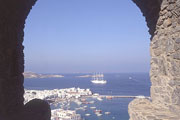History
 Mykonos Greece owns its name from the son of the King of Delos. According to mythology, Hercules, in one of his twelve tasks, was fighting the Giants and, having killed them, he threw them in the sea where they petrified and turned into huge rocks, forming the island of Mykonos.
Mykonos Greece owns its name from the son of the King of Delos. According to mythology, Hercules, in one of his twelve tasks, was fighting the Giants and, having killed them, he threw them in the sea where they petrified and turned into huge rocks, forming the island of Mykonos. In 1207, like the rest of the Cyclades, Mykonos came under Venetian rule. The Gizi dynasty took the authority of the island as well as the one of the island of Tinos.
A century later, Georgios Gizi, the last Venetian ruler, concede the island of Mykonos to Venice. In 1537 Mykonos, with most of the Cycladic islands, came under Turkish domination.
Because the inhabitants of the island were great sailors, they provided an important help to the War of Independence, offering their 22 ships, their 500 members of the crew and their 140 canons to the Greek Revolution against the Turkish yoke.
The heroic revolutionary figure of Mykonos is a woman, Manto Mavrogenous, who financed the Revolution, helped in the organisation of fights, participate to the Philiki Etairia (Secret Revolutionary organisation) and managed to organise troupes in order to revolt against the Turks in 1822.
After the independence of Greece in 1830, the economy of the island was completely destroyed and it has lost all its ships.
Later on, the island succeeded to reinforce their commercial power to rebuilt the economy. They most important source of income for the families was the textile. In fact, the textile of Mykonos was of such high quality that it was traded in all Greece and abroad.
The archaeological site of Delos attracted more people on the island and today tourism is the top source of income for the residents.